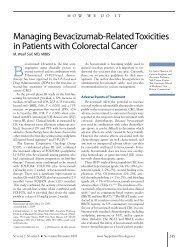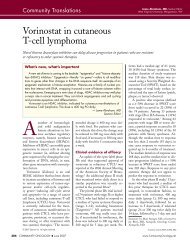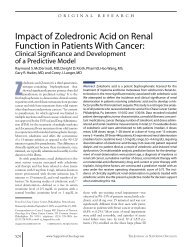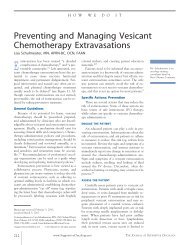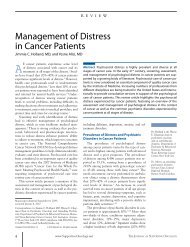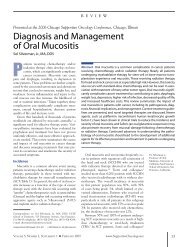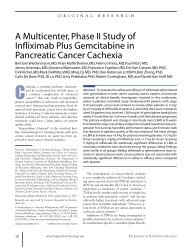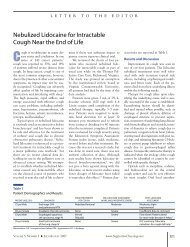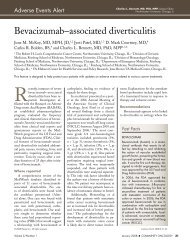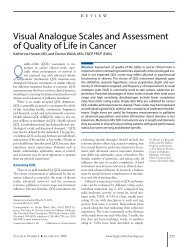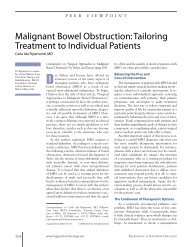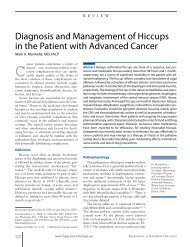Evaluating the “Good Death” Concept from Iranian Bereaved Family
Evaluating the “Good Death” Concept from Iranian Bereaved Family
Evaluating the “Good Death” Concept from Iranian Bereaved Family
Create successful ePaper yourself
Turn your PDF publications into a flip-book with our unique Google optimized e-Paper software.
(e.g., cancer pain, fibromyalgia, neuropathic pain, and<br />
joint diseases). 6<br />
The BPI-SF includes two domains: pain severity and pain<br />
interference. The pain severity domain, <strong>the</strong> focus of this<br />
report, includes items specific to pain at “worst,” “least,”<br />
“average,” and “now” (current pain), with a numerical response<br />
scale ranging <strong>from</strong> 0 (no pain) to 10 (pain as bad as<br />
you can imagine). In clinical trials, <strong>the</strong> worst pain item has<br />
been used alone as a measure of pain severity. 6 Its use as a<br />
single item is supported by a consensus panel on outcome<br />
measures for chronic pain clinical trials. 7 In addition, <strong>the</strong><br />
Food and Drug Administration’s (FDA) guidance on PROs<br />
states that a single-item PRO measure of pain severity is<br />
appropriate for assessing <strong>the</strong> effect of a treatment on pain. 8<br />
Although extensive psychometric evaluation of <strong>the</strong> BPI-SF<br />
has been conducted, no estimates of <strong>the</strong> MID are available<br />
for <strong>the</strong> BPI-SF worst pain item. Establishing <strong>the</strong> MID for<br />
<strong>the</strong> BPI-SF worst pain item is important because it will<br />
provide a clinically relevant reference to interpret changes<br />
in pain scores. Therefore, <strong>the</strong> objective of this current<br />
report was to estimate <strong>the</strong> MID of <strong>the</strong> worst pain item of<br />
<strong>the</strong> BPI-SF.<br />
Methods<br />
STUDY DESIGN<br />
Patients with advanced breast cancer and bone metastases<br />
were enrolled in an international, randomized, double-blind,<br />
double-dummy, active-controlled phase III study comparing<br />
denosumab with zoledronic acid for delaying or preventing<br />
skeletal related events. Patients were eligible to participate if<br />
<strong>the</strong>y had histologically or cytologically confirmed breast adenocarcinoma;<br />
current or prior radiologic, computed tomography,<br />
or magnetic resonance imaging evidence of at least one<br />
bone metastasis; and an Eastern Cooperative Oncology Group<br />
(ECOG) performance status of 0, 1, or 2. Patients with current<br />
or prior intravenous bisphosphonate administration were<br />
excluded. Patients completed PRO assessments, including <strong>the</strong><br />
BPI-SF, at baseline, week 5, and every 4 weeks <strong>the</strong>reafter until<br />
<strong>the</strong> end of <strong>the</strong> study. Assessments were scheduled to take<br />
place prior to any study procedures and prior to study drug<br />
administration. Although data collection continued, PRO<br />
analyses for efficacy were truncated when approximately 30%<br />
of patients dropped out of <strong>the</strong> study due to death, disease<br />
progression, or withdrawn consent.<br />
OUTCOME MEASURES AND ASSESSMENT INTERVALS<br />
A number of outcome measures were assessed in <strong>the</strong> study<br />
and considered for use as anchors for evaluating <strong>the</strong> MID of<br />
<strong>the</strong> BPI-SF worst pain item, including one clinician-reported<br />
measure (ECOG Performance Status) and several PRO measures:<br />
<strong>the</strong> EuroQoL 5 Dimensions (EQ-5D) Index score, <strong>the</strong><br />
Functional Assessment of Cancer Therapy-Breast Cancer<br />
(FACT-B), and <strong>the</strong> BPI-SF current pain rating.<br />
The ECOG Performance Status, which assesses how a<br />
patient’s disease or its treatment is progressing and how <strong>the</strong><br />
disease affects <strong>the</strong> daily living abilities of <strong>the</strong> patient, is a<br />
Mathias et al<br />
single-item, six-point, clinician-rated assessment of performance<br />
ranging <strong>from</strong> 0 (fully active, no restrictions) to 5<br />
(dead). 9 The EQ-5D Index score is a measure of health status,<br />
which assesses five dimensions: mobility, self-care, usual activities,<br />
pain/discomfort, and anxiety/depression. Each dimension<br />
is comprised of three response options: no problems,<br />
some/moderate problems, and extreme problems. Responses<br />
are converted to a weighted health state index, with scores<br />
ranging <strong>from</strong> �0.594 (worst health) to 1.0 (full health). The<br />
single item on pain <strong>from</strong> <strong>the</strong> EQ-5D was also evaluated<br />
separately as an anchor. The FACT-B includes <strong>the</strong> four core<br />
FACT-General (FACT-G) dimensions of physical well-being,<br />
social/family well-being, emotional well-being, and functional<br />
well-being, for which scale scores and a total score can<br />
be computed. In addition, <strong>the</strong> FACT-B includes a breast<br />
cancer–specific subscale. 10 The FACT-B Trial Outcome Index<br />
(TOI) is <strong>the</strong> sum of <strong>the</strong> physical well-being score, <strong>the</strong><br />
functional well-being score, and <strong>the</strong> breast cancer subscale.<br />
The four FACT-G scale scores, <strong>the</strong> FACT-G total score, <strong>the</strong><br />
FACT-B TOI, and a single-item overall quality-of-life (QOL)<br />
rating <strong>from</strong> <strong>the</strong> functional well-being section were all evaluated<br />
as potential anchors. The single-item overall QOL item<br />
<strong>from</strong> <strong>the</strong> functional well-being scale was selected to balance<br />
out <strong>the</strong> single item on pain that was selected <strong>from</strong> <strong>the</strong> EQ-5D,<br />
by serving as a more general potential anchor in breadth and<br />
scope. For all of <strong>the</strong>se FACT outcome measures, a higher<br />
score indicates better health-related QOL. Finally, <strong>the</strong> current<br />
pain rating <strong>from</strong> <strong>the</strong> BPI-SF, ranging <strong>from</strong> 0 (no pain) to<br />
10 (pain as bad as you can imagine), was also considered as an<br />
anchor because it was hypo<strong>the</strong>sized to be highly correlated<br />
with <strong>the</strong> worst pain rating and because it would assist in<br />
understanding <strong>the</strong> behavior of o<strong>the</strong>r potential anchors.<br />
Several assessment intervals were considered for evaluation<br />
of <strong>the</strong> MID for <strong>the</strong> BPI-SF worst pain item: baseline to<br />
week 5, baseline to week 13, and baseline to week 25. The<br />
analysis for each time interval included only those patients<br />
with complete baseline and end-of-interval (i.e., week 5,<br />
week 13, or week 25) assessments on <strong>the</strong> BPI-SF worst pain<br />
item and <strong>the</strong> relevant anchor of interest. In addition, a post<br />
hoc confirmatory analysis was conducted using a longer interval<br />
of time, <strong>from</strong> baseline to week 49. No imputation of<br />
missing data was performed. Analysis was performed on<br />
pooled data, regardless of treatment assignment.<br />
ANCHOR-BASED ANALYSIS<br />
The usefulness of an anchor depends on <strong>the</strong> correlation<br />
of <strong>the</strong> PRO change score and <strong>the</strong> anchor. 11 Therefore, to<br />
select <strong>the</strong> most appropriate anchors and time interval for estimating<br />
<strong>the</strong> MID for <strong>the</strong> BPI-SF worst pain item, Spearman<br />
correlation coefficients were calculated between changes in<br />
<strong>the</strong> BPI-SF worst pain rating and changes in potential anchors<br />
across each of <strong>the</strong> potential time intervals. The time interval<br />
with <strong>the</strong> highest correlations and <strong>the</strong> anchors with statistically<br />
significant (P � 0.05) a priori specified correlations above 0.30<br />
were selected for inclusion in <strong>the</strong> MID analysis. 12<br />
VOLUME 9, NUMBER 1 � JANUARY/FEBRUARY 2011 www.SupportiveOncology.net 73



